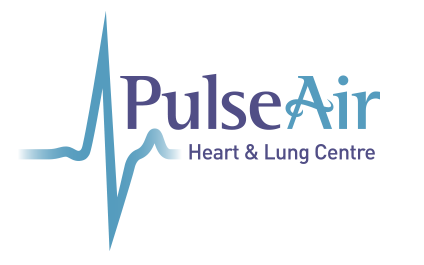Breathing is something most of us don’t think about, until it becomes harder to do. For people living with pulmonary fibrosis (PF), the simple act of drawing in air can feel like a constant uphill battle.
September is Pulmonary Fibrosis Awareness Month, making it the perfect time to talk about what PF is, why early detection matters, and how the team at PulseAir Heart & Lung Centre in Alberta helps diagnose and manage this serious condition.
Whether you’re experiencing symptoms, supporting a loved one, or simply want to know more, this guide will give you the facts you need, without the medical jargon.
What Is Pulmonary Fibrosis?
Pulmonary fibrosis (PF) is a type of lung disease that causes the tissue in the lungs to become thickened and scarred over time. This scarring makes it harder for the lungs to transfer oxygen into the bloodstream, which can lead to ongoing breathing difficulties.
It falls under a group of conditions called interstitial lung diseases (ILDs), which affect the area around the tiny air sacs in the lungs, where oxygen normally moves into the blood. When this area becomes damaged, the lungs can’t work as efficiently.
In some cases, pulmonary fibrosis is linked to environmental exposures or other health conditions. But often, the cause isn’t known. When that’s the case, it’s called Idiopathic Pulmonary Fibrosis (IPF) — “idiopathic” simply means the cause is unclear.
The condition most commonly affects people over the age of 50, but it can occur at any age, especially if certain risk factors are present.
Early Signs: What to Watch For
The earlier PF is diagnosed, the more treatment options can help slow its progression. Unfortunately, the early symptoms are easy to overlook.
If you notice any of the following, it’s worth speaking to your healthcare provider:
- Persistent dry cough lasting three months or more
- Shortness of breath (especially during activities you used to handle easily)
- Unexplained fatigue or weakness
- Unintentional weight loss
- Clubbing of fingers or toes (widening and rounding of the tips)
- A “crackling” sound in the lungs when your doctor listens with a stethoscope
These signs don’t always mean PF, but they are worth investigating, especially if you have risk factors.
Who’s at Risk?
Pulmonary fibrosis can happen to anyone, but certain factors increase the likelihood:
- Age: Most common in people over 50
- Smoking history: Current or past smoking increases risk
- Occupational or environmental exposure: Dust, asbestos, silica, metal particles, or other lung irritants
- Medical conditions: Autoimmune disorders like rheumatoid arthritis or scleroderma
- Family history: Some forms of PF run in families
If you fit into one or more of these categories and have symptoms, don’t wait — early assessment is key.
Book a Respiratory Consultation at PulseAir
How Pulmonary Fibrosis Is Diagnosed
PF is often challenging to diagnose because symptoms mimic other lung diseases, like asthma or COPD. On average, diagnosis can be delayed by more than two years, but at PulseAir, our goal is to shorten that time.
A complete evaluation may include:
- Chest X-rays to look for scarring
- High-Resolution CT (HRCT) Scans, which can detect PF earlier and more accurately than X-rays
- Pulmonary Function Tests (PFTs) to measure how well your lungs are working
- Oxygen level checks at rest and during activity
- In some cases, a lung biopsy may be needed to confirm the diagnosis
By combining advanced diagnostic tools with expert clinical assessment, our team can help identify PF as early as possible.
Learn More About Respiratory Consultations
Related: Understanding the Importance of Pulmonary Function Testing
Managing Pulmonary Fibrosis
There is currently no cure for PF, but treatments can slow the progression and improve quality of life.
Treatment plans may include:
- Medications such as antifibrotics (pirfenidone, nintedanib)
- Oxygen therapy to improve energy and reduce breathlessness
- Pulmonary rehabilitation for breathing exercises, fitness, and education
- Vaccinations (flu, pneumonia, COVID-19) to prevent respiratory infections
- Nutritional and lifestyle support to maintain overall health
- In advanced cases, evaluation for lung transplantation
Equally important is emotional support, for both patients and caregivers. Living with PF can be challenging, but having a strong care team and community can make a significant difference.
Related: Cold Weather and Your Lungs: What You Need to Know
How PulseAir Helps Albertans with Pulmonary Fibrosis
At PulseAir Heart & Lung Centre, our mission is to help Albertans breathe easier, whether that means detecting PF early, managing symptoms, or supporting you through ongoing treatment.
Our services include:
- Specialized lung testing (including advanced PFTs)
- Oxygen therapy programs
- Personalized care plans for managing chronic lung conditions
- Collaboration with specialists and transplant centres when needed
- Education for patients and families to feel confident about their care
We believe in a whole-person approach, addressing both the physical and emotional aspects of lung health.
Related: What a Respiratory Consultation Means for You
The Takeaway
Pulmonary fibrosis is a serious condition, but knowledge is power. Recognizing the signs early, getting an accurate diagnosis, and starting treatment can help slow its progression and improve quality of life.
If you’ve been experiencing unexplained shortness of breath, a stubborn cough, or other symptoms, don’t ignore them. Book an appointment at PulseAir Heart & Lung Centre to get answers and take control of your lung health.
Your lungs work hard for you every day. Let’s give them the care they deserve. Contact us today to schedule your respiratory assessment and learn more about our pulmonary fibrosis services.
Schedule Your Respiratory Assessment


